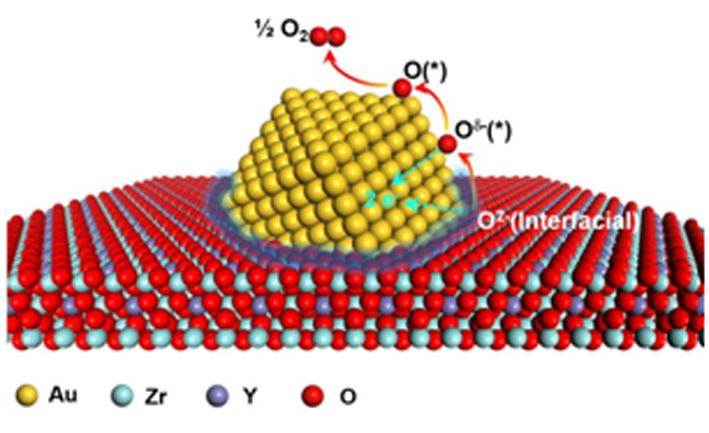Recently, the research group led by Prof. Guoxiong Wang and Prof. Xinhe Bao from Dalian Institute of Chemical Physics, Chinese Academy of Sciences, cooperating with Prof. Jijun Zhao’ group from Dalian University of Technology and Prof. Zhi Liu’ group from Shanghai Institute of Microsystem and Information Technology, Chinese Academy of Sciences, achieved highly effective oxygen evolution reaction at high temperature in solid oxide electrolysis cell (SOEC) for CO2 electrolysis by constructing Au/YSZ interface. The paper was published by Angewandte Chemie-International Edition (DOI: 10.1002/anie.201814612).

High-temperature CO2 electrolysis in SOEC has ignited increasing research interests due to its ability to reduce the atmospheric CO2 concentration and simultaneously provide a stable storage technology for renewable energy resources, such as solar, wind and so on. Improving the sluggish kinetics of oxygen evolution reaction (OER) is a grand challenge for SOEC. Perovskite oxide has been widely investigated for catalyzing the OER, however, the formation of cation-enriched secondary phases at the oxide/oxide interface blocks the active sites and decreases the OER performance. Herein, we show that the current density for Au/YSZ-7.7 anode can reach 1.39 A cm-2 at 1.4 V and 800 oC with high stability, which is much higher than the infiltrated LSM/YSZ anode. Electrochemical characterizations and density functional theory calculations suggest that the Au/YSZ interface provides a favorable path for OER by triggering the interfacial oxygen spillover from YSZ to Au surface. In situ X-ray photoelectron spectroscopy results confirm the existence of spillover oxygen on the Au surface. This study not only introduces a remarkable catalytic property of metal/oxide interface into OER at high temperature, but also provides an alternative perspective to understand the OER mechanism at high temperatures in SOEC, which is instructive for exploring efficient anode materials.
This work is supported by the National Key R&D Program of China (Grant 2017YFA0700102) and the National Natural Science Foundation of China (Grants 21573222 and 91545202). (Text by Yuefeng Song)